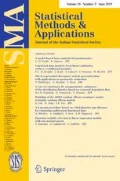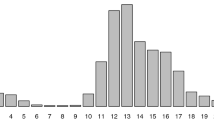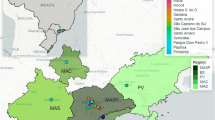Abstract
One of the main concerns in air pollution is excessive tropospheric ozone concentration. The aim of this work is to develop statistical models giving shortterm forecasts of future ground-level ozone concentrations. Since there are few physical insights about the dynamic relationship between ozone, precursor emissions and/or meteorological factors, a nonparametric and nonlinear approach seems promising in order to specify the forecast models. First, we apply four nonparametric procedures to forecast daily maximum 1-hour and maximum 8-hour averages of ozone concentrations in an urban area. Then, in order to improve the forecast performances, we combine the time series of the forecasts. This idea seems to give encouraging results.
Similar content being viewed by others
References
Billings SA, Voon WSF (1986) Correlation based model validity tests for non-linear models. International Journal of Control 44:235–244
Box GEP, Jenkins GM (1976) Time Series Analysis: Forecasting and Control (second edition). Holden Day, San Francisco
Breiman L, Friedman J, Olshen R, Stone C (1984) Classification and Regression Trees, Wadsworth, Belmont CA
Burrows WR, Benjamin M, Beauchamp S, Lord ER, McCollor D, Thomson B (1995) CART decisiontree statistical analysis and prediction of summer season maximum surface ozone for the Vancouver, Montreal and Atlantic regions of Canada. Journal of Applied Meteorology 34:1848–1862
Chen R, Tsay RS (1993) Nonlinear additive ARX models Journal of the American Statistical Association 88:955–967
Clemen RT (1989) Combining forecasts: a review and annotated bibliography. International Journal of Forecasting 5:559–583
Cobourn WG, Hubbard MC (1999) An enhanced ozone forecasting model using air mass trajectory analysis. Atmospheric Environment 33:4663–4674
Comrie AC (1997) Comparing neural networks and regression models for ozone forecasting. Journal of the Air & Waste Management Association 47:653–663
Davis JM, Speckman P (1999) A model for predicting maximum and 8h average ozone in Houston. Atmospheric Environment 33:2487–2500
De Leeuwe FAAA (2000) Criteria for evaluation of smog forecast systems. Environmental Monitoring and Assessment 60:1–14
Finzi G, Bergoli D, Volta M (1999) Modelli per la previsione di episodi critici di ozono troposferico in accordo alle linee guida europee. Atti del Convegno SCO99:399–404
Freund Y, Schapire RE (1997) A decision-theoretic generalization of on-line learning and an application to boosting. Journal of Computer and System Sciences 55:119–139
Friedman JH (1991) Multivariate adaptive regression splines. The Annals of Statistics 19:1–50
Graf-Jaccottet M, Jaunin MH (1998) Predictive models for ground ozone and nitrogen dioxide time series. Environmetrics 9:393–406
Granger CWJ, Ramanathan R (1984) Improved methods of forecasting. Journal of Forecasting 3:197–204
Härdle W, Lütkepohl H, Chen R (1997) A review of nonparametric time series analysis. International Statistical Review 65:49–72
Hastie TJ, Tibshirani RJ (1990) Generalized Additive Models. Chapman and Hall, New York
Hertz J, Krogh A, Palmer R (1991) Introduction to the Theory of Neural Computation. Addison-Wesley, Reading MA
Hornik K, Stinchcombe M, White H (1989) Multilayer feedforward networks. Neural Networks 4: 251–257
Jorquera H, Perez R, Cipriano A, Espejo A, Letelier MV, Acuna G (1988) Forecasting ozone daily maximum level at Santiago, Chile. Atmospheric Environment 32:3415–3424
Milionis AE, Davies TD (1994) Regression and stochastic models for air pollution—I Review, comments and suggestions. Atmospheric Environment 28:2801–2810
Niu X (1996) Nonlinear additive models for environmental time series with applications to ground-level ozone data analysis. Journal of the American Statistical Association 91:1310–1321
Prybutok VR, Yi J, Mitchell A (2000) Comparison of neural network models with ARIMA and regression models for prediction of Houston's daily maximum ozone concentrations. European Journal of Operational Research 122:31–40
Ryan WF (1995) Forecasting severe ozone episodes in the Baltimore metropolitan area. Atmospheric Environment 29:2387–2398
Seinfeld JH (1986) Atmospheric Chemistry and Physics of Air Pollution. Wiley, New York
Sjöberg J, Zhang Q, Ljung L, Benveniste A, Delyon B, Glorennec P, Hjalmarsson H, Juditsky A (1995) Nonlinear black-box modeling in system identification: a unified overview Automatica 31:1691–1724
Venables WN, Ripley BD (1997) Modern Applied Statistics with S-Plus (second edition). Springer, New York
Yang Y, Barron AR (1998) An asymptotic property of model selection criteria. IEEE Trans on Information Theory 44:95–116
Author information
Authors and Affiliations
Corresponding author
Additional information
This work was supported by a MURST grant. The authors would like to thank two anonymous referees for their helpful comments.
Rights and permissions
About this article
Cite this article
Bordignon, S., Gaetan, C. & Lisi, F. Nonlinear models for ground-level ozone forecasting. Statistical Methods & Applications 11, 227–245 (2002). https://doi.org/10.1007/BF02511489
Issue Date:
DOI: https://doi.org/10.1007/BF02511489




